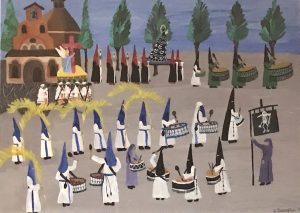This is the painting that I have put in the corner of the den – a sort of private place in my house, as most people without knowledge of world religious customs and knowing nothing about the cultural traditions of Spain would likely take one look at it and begin melting down into puddles of deeply offended goo. I bought it from the artist herself, along with two other paintings. She had a table next to mine at an NCO Wives’ Club Christmas bazaar at Zaragoza AB sometime in the late 1980s. I was selling bespoke Cabbage Patch doll clothes and making a mint; she had her lovely folk-art paintings and wasn’t selling a single one, and I felt so sorry for her – as well as loving the simple Grandma Moses-style vibe – that I bought three of them. (One – of a street market in Spain – I gave to my brother as a wedding present, as I was skint at the time. I would have asked for it back when he and that wife divorced, but one of his subsequent girlfriends loved it, and took it with her when they broke up. Damn. But I still have two – this one, and a small one of boats drawn up on the beach.)
No, it is not a KKK march – it is, in fact, a tradition far, far older and from another country – Spain, from which the KKK boosted the whole robes, pointed headgear and masks concept wholesale and likely without attribution. My painting depicts a procession of a religious association, a confraternity – a traditional charitable organization with deeply religious overtones. The confraternities in Seville are the most well-known; most famous for their spectacular processions, carrying images of the Passion, the saints, the Virgin and Christ through the streets during Holy Week. But Zaragoza and other cities also have confraternities which would parade the streets of the city with ritual, drums and trumpets during Easter Week. One year, one of the Zaragoza confraternities paraded on the major avenue next to the San Lamberto urbanization where we lived at the time. It may have been a one-off, for I never saw or heard of them any other time, and the avenue was a major and heavily-traveled artery to Logrono, the next big town to the north. The men in their heavy, ornate robes and masks, marching in the twilight, with the religious image carried on the shoulders on a big float, and the sound of the drums echoing off the tall apartment block at the edge of San Lamberto … It was deeply spooky; I believe there were torches involved, along with the drums and possibly trumpets. Feeling nostalgic this last weekend, I called up google street view. San Lamberto seems to have changed little, although the duplex that we lived in has been added onto and expanded. But I can’t retrace the back road that was a short-cut to the base and to the commercial air terminal from San Lamberto – there is now an enormous highway interchange laid out over top of that little road. But the confraternities in Zaragoza are still active, of course – I did find some Youtube videos of the marches, with the drummers and all. Nice to know that some things don’t change at all.


Recent Comments